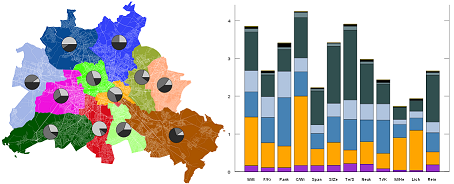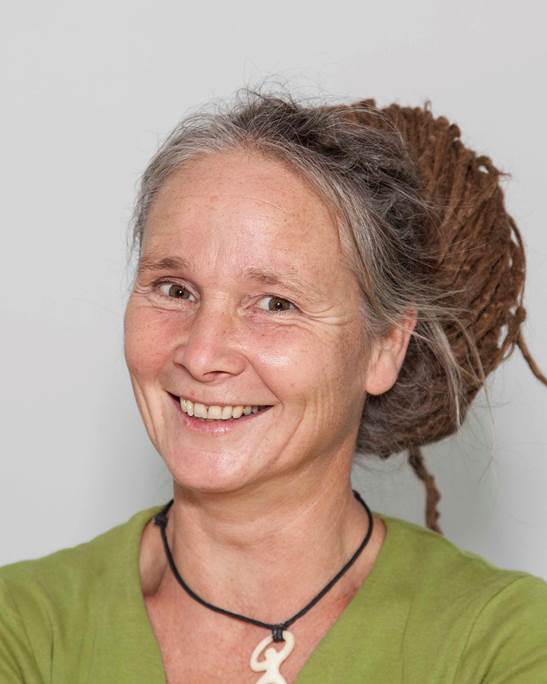Erneuerbare Energien und Elektromobilität in Berlin (Twele 2011)
27. September 2011Tool for calculating the influence of the renovation level, energy sources and the type of heating of Berlin

Project period
01.09.2011 - 31.08.2012
As long ago as 2007, the HTW (Prof. Twele, Mr. Buddeke and Mr. Stark) conducted a heat study commissioned by BUND (Friends of the Earth Germany). In 2011/12, the RLI updated and completed the basic data – also commissioned by BUND – and refined the calculations which resulted in a calculation tool in a new programming environment.
With this new calculation tool it is possible to analyse the influences of the renovation level, energy sources and the type of heating of Berlin (residential) buildings on the primary energy balance and the CO2 balance. The potential of different measures can be demonstrated through clear graphics. It can also determine the renovation costs of the (different) scenarios.
Beyond the scenario calculation, costs for individual measures on buildings and heating can be provided.
District comparisons (statistical districts, old districts, districts) or different measures can be carried out to respectively compare scenarios within a district.
An input form was developed in order to help the user create scenarios. The resulting outputs were automated.
The calculation tool is essentially based on the following information and simulations:
- Marking the type of the city structure and the pro rata type of heating sources, resolved by statistical blocks.(source: Umweltatlas der Berliner Senatsverwaltung für Stadtentwicklung (database 2005))
- Allocation of urban structure types to building categories in accordance with the IWU standard
- Allocation of specific load curves of thermal heat to building categories (simulation in TRNSYS)
- Calculation of investment costs according to DIN 4701-10
- Allocation of solar facilities and potentials of the Solar Atlas (Berlin partners) to the statistical blocks
- Allocation of typical renovation cost to reduction of thermal heat needed, by type of building in accordance with usual sets of measures (roof, basement, facade, windows); respectively installation costs of the installation refurbishment
- Linking of thermal heat need, installation standard, primary energy demand and CO2 emissions using efficiencies and specific values of energy sources. In this regard, one can choose from balancing in accordance with the Finnish Method or other methods.
By collecting current and sophisticated data from individual districts, they can be refined in this block structure and viewed individually.
As long ago as 2007, the HTW (Prof. Twele, Mr. Buddeke and Mr. Stark) conducted a heat study commissioned by BUND (Friends of the Earth Germany). In 2011/12, the RLI updated and completed the basic data – also commissioned by BUND – and refined the calculations which resulted in a calculation tool in a new programming environment.
With this new calculation tool it is possible to analyse the influences of the renovation level, energy sources and the type of heating of Berlin (residential) buildings on the primary energy balance and the CO2 balance. The potential of different measures can be demonstrated through clear graphics. It can also determine the renovation costs of the (different) scenarios.
Beyond the scenario calculation, costs for individual measures on buildings and heating can be provided.
District comparisons (statistical districts, old districts, districts) or different measures can be carried out to respectively compare scenarios within a district.
An input form was developed in order to help the user create scenarios. The resulting outputs were automated.
The calculation tool is essentially based on the following information and simulations:
- Marking the type of the city structure and the pro rata type of heating sources, resolved by statistical blocks.(source: Umweltatlas der Berliner Senatsverwaltung für Stadtentwicklung (database 2005))
- Allocation of urban structure types to building categories in accordance with the IWU standard
- Allocation of specific load curves of thermal heat to building categories (simulation in TRNSYS)
- Calculation of investment costs according to DIN 4701-10
- Allocation of solar facilities and potentials of the Solar Atlas (Berlin partners) to the statistical blocks
- Allocation of typical renovation cost to reduction of thermal heat needed, by type of building in accordance with usual sets of measures (roof, basement, facade, windows); respectively installation costs of the installation refurbishment
- Linking of thermal heat need, installation standard, primary energy demand and CO2 emissions using efficiencies and specific values of energy sources. In this regard, one can choose from balancing in accordance with the Finnish Method or other methods.
By collecting current and sophisticated data from individual districts, they can be refined in this block structure and viewed individually.
The objective of this project is to investigate a possible contribution of heating networks and cogeneration plants (CHP) for the economic aspect of the transformation of the energy sector towards a stable and low CO2 energy supply.






